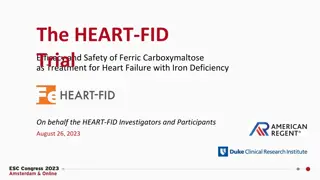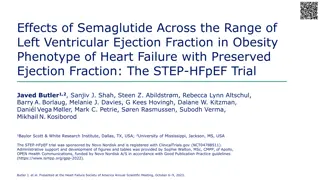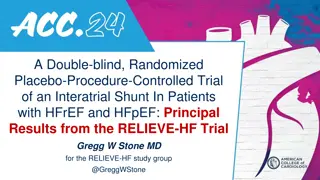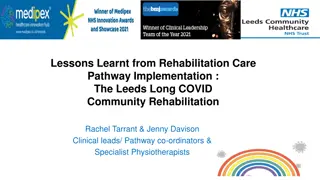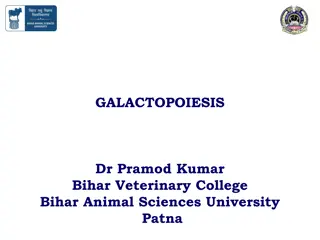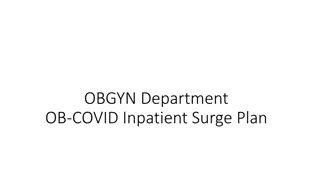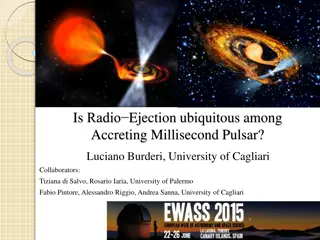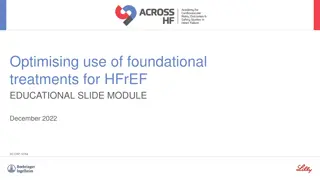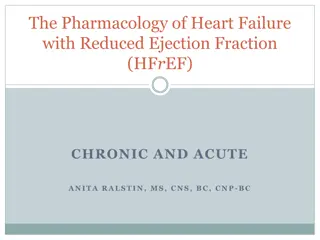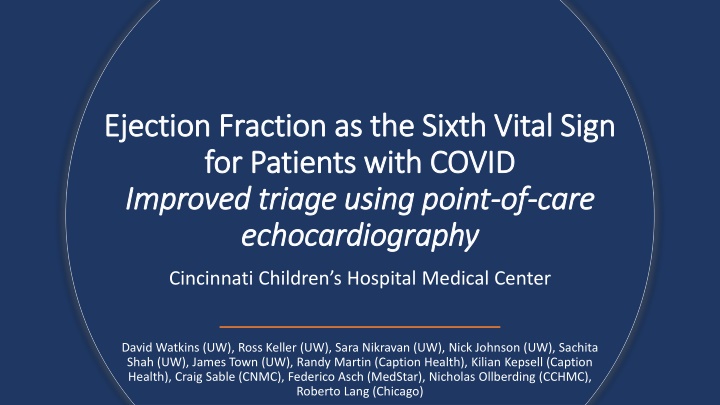
Improved Triage Using Ejection Fraction as Sixth Vital Sign for COVID Patients
Enhancing patient management in COVID by employing ejection fraction as the sixth vital sign, facilitating early identification of myocardial dysfunction. This approach utilizes point-of-care echocardiography to address limitations in access to echocardiography and skilled human resources, promoting task sharing and improved outcomes. Additionally, prescriptive guidance aids in the rapid scale-up of non-expert echocardiography, with navigational guidance providing technology solutions for probe positioning and diagnostic quality feedback.
Download Presentation

Please find below an Image/Link to download the presentation.
The content on the website is provided AS IS for your information and personal use only. It may not be sold, licensed, or shared on other websites without obtaining consent from the author. If you encounter any issues during the download, it is possible that the publisher has removed the file from their server.
You are allowed to download the files provided on this website for personal or commercial use, subject to the condition that they are used lawfully. All files are the property of their respective owners.
The content on the website is provided AS IS for your information and personal use only. It may not be sold, licensed, or shared on other websites without obtaining consent from the author.
E N D
Presentation Transcript
Ejection Fraction as the Sixth Vital Sign Ejection Fraction as the Sixth Vital Sign for Patients with COVID for Patients with COVID Improved triage using point Improved triage using point- -of of- -care echocardiography echocardiography care Cincinnati Children s Hospital Medical Center David Watkins (UW), Ross Keller (UW), Sara Nikravan (UW), Nick Johnson (UW), Sachita Shah (UW), James Town (UW), Randy Martin (Caption Health), Kilian Kepsell (Caption Health), Craig Sable (CNMC), Federico Asch (MedStar), Nicholas Ollberding (CCHMC), Roberto Lang (Chicago)
Background Background Myocardial Injury Myocardial Injury Arrythmia Arrythmia Cardiac Dysfunction Cardiac Dysfunction Early identification of patients with myocardial Early identification of patients with myocardial dysfunction may improve management. dysfunction may improve management.
Background Background Limited provider Limited provider- -to to- - patient contact patient contact Lack of skilled human Lack of skilled human resources (LMICs) resources (LMICs) PPE conservation PPE conservation Access to echocardiography is limited in many Access to echocardiography is limited in many settings. settings.
Background Background Conserve resources Conserve resources Improve access to diagnosis Improve access to diagnosis Change outcomes Change outcomes Task sharing echocardiography with frontline Task sharing echocardiography with frontline healthcare providers may serve as a 6 healthcare providers may serve as a 6th thvital sign that can be integrated with POC testing that can be integrated with POC testing . . vital sign
Quality Meter Background Background Prescriptive Guidance Reference Image Rapid scale up of Rapid scale up of non non- -expert echo expert echo has challenges has challenges Navigational Navigational guidance provides guidance provides a technology a technology solution solution Probe Positioning Diagram AutoCapture Save Best Clip Caption Guidance provides real time feedback on probe position and diagnostic quality
Specific Aims Specific Aims (1)Compare the efficiency and quality of FoCUS with and without AI-assistance in the COVID ED (2)Describe the longitudinal pattern of EF in critically ill patients with COVID in the ICU (3)Evaluate frontline provider experience with AI-guided FoCUS in the ED and ICU (4) Develop a simple risk prediction score that integrates EF to improve triage of patients with COVID infection.
ED Cohort ED Cohort n=100 Non-intubated, >18 years, suspected or confirmed COVID-19 Randomized to NG + Auto EF or non- assisted FoCUS first ICU Cohort n=25 Outcomes at 30-60 days Comparison of image acquisition time and image quality Clinical Prediction Cohort n > 300 Provider survey Technology Acceptability Model (TAM) + survey on ease of workflow integration
ICU Cohort ICU Cohort ED Cohort n=100 >18 years, confirmed COVID-19, admitted to the ICU >18 years, confirmed COVID-19, admitted to the ICU NG Echo and lung u/s integrated into clinical workflow daily ICU Cohort n=25 NG Echo and lung u/s integrated into clinical workflow daily Provider survey Technology Acceptability Model (TAM) + survey on ease of workflow integration Provider survey Technology Acceptability Model (TAM) + survey on ease of workflow integration Linear mixed-effects regression (LMER) change in EF during ICU stay, differences in outcome modeled Clinical Prediction Cohort n > 300 Linear mixed-effects regression (LMER) change in EF during ICU stay
Clinical Prediction Cohort ED Cohort n=100 >300 patients recruited across centers Demographic and clinical data, echo within 24 hours of presentation, outcomes data ICU Cohort n=25 Echo images uploaded (when approved) to Cloud-based storage Clinical Prediction Cohort n > 300 Multivariate regression predict probability for critical illness *FOCUS on POC findings that would be available in a low-resource environment
Overall Timeline May June July Aug Sept Oct Nov Dec Jan Feb Mar April COVID Research Committee IRB DUA Agreement Trice Cloud Platform Aim 1 Recruitment Aim 2 Recruitment Aim 3 Recruitment
Ejection Fraction as the Sixth Vital Sign Ejection Fraction as the Sixth Vital Sign for Patients with COVID for Patients with COVID Improved triage using point Improved triage using point- -of of- -care echocardiography echocardiography care

